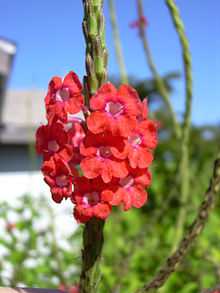Stachytarpheta mutabilis
| Stachytarpheta mutabilis | |
|---|---|
 | |
| Scientific classification | |
| Kingdom: | Plantae |
| (unranked): | Angiosperms |
| (unranked): | Eudicots |
| (unranked): | Asterids |
| Order: | Lamiales |
| Family: | Verbenaceae |
| Genus: | Stachytarpheta |
| Species: | S. mutabilis |
| Binomial name | |
| Stachytarpheta mutabilis (Jacq.) Vahl | |
Stachytarpheta mutabilis is a species of flowering plant in the verbena family known by the common names changeable velvetberry,[1] coral porterweed, pink snakeweed, red snakeweed,[2] and pink rat tail.[3] It is native to Mexico, the Caribbean, and South America.[2] It can be found in many other places as an introduced species. It is cultivated as an ornamental plant.[3]
This species is a perennial herb or subshrub generally growing 10 to 20 centimeters tall, sometimes reaching half a meter. The hairy stems have oppositely arranged leaves. The leaf blades are leathery in texture and oblong or lance-shaped. They measure up to 12 centimeters long. The inflorescence is a narrow spike up to 60 centimeters long. The flowers come in many shades of red and pink.[3]
This species sometimes escapes cultivation and becomes established in the wild. It can be weedy, growing in disturbed habitat such as pastures and roadsides.[3]
This plant is an introduced invasive species in Fiji, Hawaii, Queensland, and Singapore.[3]
The flowers are attractive to a variety of insects. The butterflies Ornithoptera priamus poseidon and Papilio ulysses have been observed foraging on the plant, as has the bee Amegilla sapiens.[4] Parts of the plant contain the iridoid glycoside ipolamiide, which inhibits insect predation on the plant.[5]
| Wikimedia Commons has media related to Stachytarpheta mutabilis. |
References
- ↑ Stachytarpheta mutabilis. USDA Plants Profile.
- ↑ 2.0 2.1 Stachytarpheta mutabilis. Germplasm Resources Information Network.
- ↑ 3.0 3.1 3.2 3.3 3.4 Stachytarpheta mutabilis. Pacific Island Ecosystems at Risk.
- ↑ Stone, G. N., et al. (1988). Thermal effects on activity patterns and behavioural switching in a concourse of foragers on Stachytarpheta mutabilis (Verbenaceae) in Papua New Guinea. Oecologia 77(1) 56-63.
- ↑ Bernays, E. and C. De Luca. (1981). Insect antifeedant properties of an iridoid glycoside: ipolamiide. Cellular and Molecular Life Sciences 37(12) 1289-90.